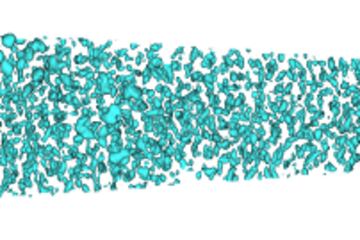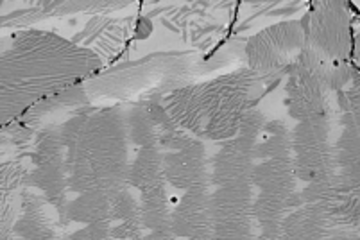All genres
41.
Journal Article
Influence of Microstructure and Atomic-Scale Chemistry on Iron Ore Reduction with Hydrogen at 700°C. Acta Materialia 212, 116933 (2021)
42.
Journal Article
Multiphase-field simulation of austenite reversion in medium-Mn steels. International Journal of Minerals, Metallurgy and Materials 28 (5), pp. 847 - 853 (2021)
43.
Journal Article
Phase boundary segregation-induced strengthening and discontinuous yielding in ultrafine-grained duplex medium-Mn steels. Acta Materialia 200, pp. 389 - 403 (2020)
44.
Journal Article
On the hydrogen embrittlement behavior of nickel-based alloys: Alloys 718 and 725. Materials Science and Engineering A: Structural Materials Properties Microstructure and Processing 792, 139785 (2020)
45.
Journal Article
Macroscopic to nanoscopic in situ investigation on yielding mechanisms in ultrafine grained medium Mn steels: Role of the austenite-ferrite interface. Acta Materialia 178, pp. 10 - 25 (2019)
46.
Conference Paper
Hydrogen Plasma Reduction of Iron Oxides. Advances in Pyrometallurgy Symposium, held at the TMS Annual Meeting and Exhibition, TMS 2023, San Diego, CA, USA, March 19, 2023 - March 23, 2023. The Minerals, Metals & Materials Serie, pp. 83 - 84 (2023)
47.
Conference Paper
Hydrogen-Based Direct Reduction of Iron Oxides. Advances in Pyrometallurgy Symposium, held at the TMS Annual Meeting and Exhibition, TMS 2023, San Diego, CA, USA, March 19, 2023 - March 23, 2023. JOM-Journal of the Minerals Metals & Materials Society, pp. 107 - 108 (2023)
48.
Talk
New insights into hierarchical microstructure formation during green ironmaking with hydrogen. The ESRF ID03-ID11, Grenoble, France (2024)
49.
Talk
Hydrogen-based transformation of the steel industry. Green Ironmaking with Hydrogen and Ammonia, Düsseldorf, Germany (2024)
50.
Talk
Basic science behind sustainable ironmaking with hydrogen and ammonia. International Seminar on Hydrogen Use in Process Metallurgy, Trondheim, Norway (2024)
51.
Talk
Hydrogen-based and Ammonia-based Direct Reduction of Iron Oxides. Seminar at McMaster University, Online (2024)
52.
Talk
Discontinuous yielding in ultrafine-grained duplex medium-Mn steels. Discontinuous yielding in ultrafine-grained duplex medium-Mn steels, Darmstadt, Germany (2023)
53.
Talk
Reducing Iron Oxide with Ammonia: A Sustainable Path to Green Steel. EUROMAT2023, Frankfurt am Main, Germany (2023)
54.
Talk
The chemical, thermodynamic and kinetic roles of pores in the hydrogen-based direct reduction of single-crystalline wüstite into iron. EUROMAT 2023, Frankfurt, Germany (2023)
55.
Talk
Basic science behind green steel making. 2023 International Symposium on Hydrogen Metallurgy (ISHM2023), Chongli, China (2023)
56.
Talk
Porosity evolution during sustainable ironmaking with hydrogen probed by 4D synchrotron X-ray nano-tomography. European Synchrotron Radiation Facility User Meeting 2023, Grenoble, France (2023)
57.
Talk
Microstructure evolution during hydrogen-based direct reduction of iron oxides. International Workshop on Sustainable Metallurgy of Green Steel (GreenSteel2022), online (2022)
58.
Talk
Green steel: porosity evolution during hydrogen-based direct reduction of hematite probed by in-situ synchrotron X-ray nano-tomography. MSE 2022, Darmstadt, Germany (2022)
59.
Talk
Reduced toughness of recrystallised tungsten at grain boundaries evidenced through site-specific microcantilever fracture testing. 11th European Solid Mechanics Conference - ESMC 2022, Galway, Ireland (2022)
60.
Talk
Microstructure and porosity evolution during hydrogen-based direct reduction of iron ore. DGM X-ray tomography working group meeting, online (2022)











